A Predictive Model for Cropland Transformation at the Regional Level: A Case Study of the Belgorod Oblast, European Russia
Abstract
:1. Introduction
2. Study Area
3. Materials and Methods
3.1. Data Sources
3.2. Statistical and Spatial Modeling Methods
3.2.1. Statistical Model of Cultivated Land Area Dynamics
3.2.2. Spatial Probabilistic Model of an Urbanized Territory
4. Results
4.1. Forecasting the Area of Cropland in the Land Fund of the Belgorod Oblast
4.2. Spatial Model of the Dynamics of Cropland in an Urbanized Area
- (1)
- For the development of urban and suburban areas. Of the total area of reduced cropland, 82% is occupied by land of the private residential sector, 2% by infrastructure land (roads, communications, etc.), and 3% by industrial enterprises (agricultural and manufacturing industries).
- (2)
- For private horticultural farms. These are the so-called dachas, designed to accommodate private gardens of the population (mainly urban) without permanent residence in these territories. These territories make up 7% of the reduced cropland.
- (3)
- When converting cropland into meadows. The share of such lands is 6%. Most of these sites are located on slopes that are inconvenient for cultivation, adjacent to the gully and small-dry-valley network, and some of them are actively overgrown with trees and shrubs. Therefore, their re-engagement into plowing at the initiative of land users is unlikely and they can be considered abandoned.
5. Discussion
6. Conclusions
Author Contributions
Funding
Institutional Review Board Statement
Informed Consent Statement
Data Availability Statement
Conflicts of Interest
References
- FAO. The State of the World’s Land and Water Resources for Food and Agriculture—Systems at Breaking Point; Main Report; FAO: Rome, Italy, 2022. [Google Scholar] [CrossRef]
- Lisetskii, F. Water resources of rivers and erosion-accumulation processes. Biosci. Biotechnol. Res. Commun. 2022, 15, 580–582. [Google Scholar] [CrossRef]
- Cameron, D.; Osborne, C.; Horton, P.; Sinclair, M.A. Sustainable Model for Intensive Agriculture; Grantham Centre Briefing Note; Grantham Centre for Sustainable Futures & the University of Sheffield: Sheffield, UK, 2015. [Google Scholar]
- Colsaet, A.; Laurans, Y.; Levrel, H. What drives land take and urban land expansion? A systematic review. Land Use Policy 2018, 79, 339–349. [Google Scholar] [CrossRef]
- Hanta, E.; Bakker, M. Abandonment and expansion of arable land in Europe. Ecosystem 2011, 14, 720–731. [Google Scholar] [CrossRef]
- Wu, X.D.; Guo, J.L.; Han, M.Y.; Chen, G.Q. An overview of arable land use for the world economy: From source to sink via the global supply chain. Land Use Policy 2018, 76, 201–214. [Google Scholar] [CrossRef]
- Voronkova, O.Y.; Akhmetshin, E.M.; Sycheva, I.N.; Shpakova, R.N.; Pashkova, E.Y.; Poltarykhin, A.L. Economic mechanism of regulating land relations in the agricultural sector of Russia. Eur. Res. Stud. J. 2018, 21, 280–291. [Google Scholar] [CrossRef]
- Prăvălie, R.; Patriche, C.; Borrelli, P.; Panagos, P.; Roșca, B.; Dumitraşcu, M.; Nita, I.; Săvulescu, I.; Birsan, M.; Bandoc, G. Arable lands under the pressure of multiple land degradation processes. A global perspective. Environ. Res. 2021, 194, 110697. [Google Scholar] [CrossRef]
- Nekrich, A.S.; Lyuri, D.I. Changes of the dynamic of agrarian lands of Russia in 1990–2014. Izv. Ross. Akad. Nauk. Seriya Geogr. 2019, 3, 64–77. (In Russian) [Google Scholar] [CrossRef]
- Golosov, V.N.; Collins, A.L.; Dobrovolskaya, N.G.; Bazhenova, O.I.; Ryzhov, Y.V.; Sidorchuk, A.Y. Soil loss on the arable lands of the forest-steppe and steppe zones of European Russia and Siberia during the period of intensive agriculture. Geoderma 2021, 381, 114678. [Google Scholar] [CrossRef]
- Gusarov, A.V. Land-use/-cover changes and their effect on soil erosion and river suspended sediment load in different landscape zones of European Russia during 1970–2017. Water 2021, 13, 1631. [Google Scholar] [CrossRef]
- Singh, S.K.; Srivastava, P.K.; Szilárd, S.; Petropoulos, G.P.; Gupta, M.; Islam, M. Landscape transform and spatial metrics for mapping spatiotemporal land cover dynamics using Earth Observation data-sets. Geocarto Int. 2016, 32, 113–127. [Google Scholar] [CrossRef]
- Soma, A.S.; Kubota, T.; Aditian, A. Comparative study of land use change and landslide susceptibility using frequency ratio, certainty factor, and logistic regression in upper area of Ujung-Loe watersheds, South Sulawesi, Indonesia. Int. J. Eros. Control Eng. 2019, 11, 103–115. [Google Scholar] [CrossRef]
- Lambin, E.F.; Rounsevell, M.D.A.; Geist, H.J. Are agricultural land-use models able to predict changes in land-use intensity? Agric. Ecosyst. Environ. 2000, 82, 321–331. [Google Scholar] [CrossRef]
- Briassoulis, H. Analysis of Land Use Change: Theoretical and Modeling Approaches, 2nd ed.; Loveridge, S., Jackson, R., Eds.; WVU Research Repository: Morgantown, WV, USA, 2020; Available online: https://researchrepository.wvu.edu/rri-web-book (accessed on 24 January 2023).
- Feng, Y.; Lei, Z.; Tong, X.; Gao, C.; Chen, S.; Wang, J.; Wang, S. Spatially-explicit modeling and intensity analysis of China’s land use change 2000–2050. J. Environ. Manag. 2020, 263, 110407. [Google Scholar] [CrossRef] [PubMed]
- Liu, D.; Zheng, X.; Wang, H. Land-use simulation and decision-support system (LandSDS): Seamlessly integrating system dynamics, agent-based model, and cellular automata. Ecol. Model. 2020, 417, 108924. [Google Scholar] [CrossRef]
- Baker, W.L. A review of models of landscape change. Landsc. Ecol. 1989, 2, 111–133. [Google Scholar] [CrossRef]
- Weng, Q. Land use change analysis in the Zhujiang delta of China using satellite remote sensing, GIS and stochastic modeling. J. Environ. Manag. 2002, 64, 273–284. [Google Scholar] [CrossRef] [PubMed]
- Kovyazin, V.F.; Thi Xuan, N. Development of predictive models of land use change in Vietnam. Bull. Tomsk Polytech. Univ. Geo Assets Eng. 2019, 330, 221–229. (In Russian) [Google Scholar]
- Hyka, I.; Hysa, A.; Dervishi, S.; Solomun, M.K.; Kuriqi, A.; Vishwakarma, D.K.; Sestras, P. Spatiotemporal dynamics of landscape transformation in Western Balkans’ metropolitan areas. Land 2022, 11, 1892. [Google Scholar] [CrossRef]
- Federal Service for State Registration. Cadaster and Cartography. State (National) Report on the State and Use of Land. Available online: https://rosreestr.gov.ru/activity/gosudarstvennoe-upravlenie-v-sfere-ispolzovaniya-i-okhrany-zemel/gosudarstvennyy-natsionalnyy-doklad-o-sostoyanii-i-ispolzovanii-zemel-rossiyskoy-federatsii/ (accessed on 24 January 2023).
- Matasov, V.; Prishchepov, A.V.; Jepsen, M.R.; Müller, D. Spatial determinants and underlying drivers of land-use transitions in European Russia from 1770 to 2010. J. Land Use Sci. 2019, 14, 362–377. [Google Scholar] [CrossRef]
- Chugunova, N.; Polyakova, T.; Morkovskaya, D.; Narozhnaya, A.; Kuharuk, N. Spatial differentiation of border areas of the Central Black Earth Region in metropolisation processes. In Proceeding of the 3rd International Conference Spatial Development of Territories (SDT 2020), Belgorod, Russia, 26–27 November 2020; Stryabkova, E., Ed.; Atlantis Press: Dordrecht, The Netherlands, 2021; Volume 181, pp. 14–19. [Google Scholar] [CrossRef]
- Lisetskii, F.N.; Buryak, Z.A. Runoff of water and its quality under the combined impact of agricultural activities and urban development in a small river basin. Water 2023, 15, 2443. [Google Scholar] [CrossRef]
- Russian Federal State Statistics Service for Belgorod Oblast. Available online: https://belg.gks.ru/belg_db (accessed on 24 January 2023).
- Public Cadastral Map of Russia. Available online: https://pkk.rosreestr.ru (accessed on 26 July 2023).
- Buryak, Z.A.; Narozhnyaya, A.G.; Gusarov, A.V.; Beylich, A.A. Solutions for the spatial organization of cropland with increased erosion risk at the regional level: A case study of Belgorod Oblast, European Russia. Land 2022, 11, 1492. [Google Scholar] [CrossRef]
- Sarkar, A.; Chouhan, P. Dynamic simulation of urban expansion based on Cellular Automata and Markov Chain Model: A case study in Siliguri Metropolitan Area, West Bengal. Model. Earth Syst. Environ. 2019, 5, 1723–1732. [Google Scholar] [CrossRef]
- Nouri, J.; Gharagozlou, A.; Arjmandi, R.; Faryadi, S.; Adl, M. Predicting urban land use changes using a CA–Markov model. Arab. J. Sci. Eng. 2014, 39, 5565–5573. [Google Scholar] [CrossRef]
- Grigoreva, O.I.; Marinina, O.A.; Zelenskaya, E.Y. Spatial and temporal changes in the land resources of the Belgorod region from 1954 to 2017 under the influence of anthropogenic factors. Biosci. Biotechnol. Res. Commun. 2020, 13, 60–67. [Google Scholar] [CrossRef]
- Prishchepov, A.V.; Müller, D.; Baumann, M.; Kuemmerle, T.; Alcantara, C.; Radeloff, V.C. Underlying drivers and spatial determinants of post-Soviet agricultural land abandonment in temperate Eastern Europe. In Land-Cover and Land-Use Changes in Eastern Europe after the Collapse of the Soviet Union in 1991; Gutman, G., Radeloff, V., Eds.; Springer: Cham, Switzerland, 2017; pp. 91–117. [Google Scholar] [CrossRef]
- Litvin, L.F.; Kiryukhina, Z.P.; Krasnov, S.F.; Dobrovol’skaya, N.G. Dynamics of agricultural soil erosion in European Russia. Eurasian Soil Sci. 2017, 50, 1344–1353. [Google Scholar] [CrossRef]
- Kitov, M.V.; Tsapkov, A.N. Assessment of the area of fallow land in the Belgorod region and other regions of European Russia for the period 1990–2013 years. Belgorod State Univ. Sci. Bull. Nat. Sci. Ser. 2015, 15, 163–171. (In Russian) [Google Scholar]
- Ivanov, M.A.; Prishchepov, A.V.; Golosov, V.N.; Zalyaliev, R.R.; Efimov, K.V.; Kondrat’eva, A.A.; Kinyashova, A.D.; Ionova, Y.K. Changes of cropland area in the river basins of the European part of Russia for the period 1985–2015, as a factor of soil erosion dynamics. Sovrem. Probl. Distantsionnogo Zondirovaniya Zemli Iz Kosmosa 2017, 14, 149–157. [Google Scholar] [CrossRef]
- Lisetskii, F.N.; Pavlyuk, Y.V.; Kirilenko, Z.A.; Pichura, V.I. Basin organization of nature management for solving hydroecological problems. Russ. Meteorol. Hydrol. 2014, 39, 550–557. [Google Scholar] [CrossRef]
- Savchenko, E.S.; Kiryushin, V.I.; Lukin, S.V. Experience of biologization of agricultural technologies during the development of adaptive-landscape agricultural systems in Belgorod region. Int. Agric. J. 2022, 6, 658–661. (In Russian) [Google Scholar] [CrossRef]
- Pavlova, V.N.; Calanca, P.; Karachenkova, A.A. Grain crops productivity in the European Part of Russia under recent climate change. Russ. Meteorol. Hydrol. 2020, 45, 290–302. [Google Scholar] [CrossRef]
- Chen, Z.; Huang, M.; Zhu, D.; Altan, O. Integrating remote sensing and a Markov-FLUS model to simulate future land use changes in Hokkaido, Japan. Remote Sens. 2021, 13, 2621. [Google Scholar] [CrossRef]
- Deng, Z.; Quan, B. Intensity characteristics and multi-scenario projection of land use and land cover change in Hengyang, China. Int. J. Environ. Res. Public Health 2022, 19, 8491. [Google Scholar] [CrossRef]
- Volkov, S.N. Complex land use planning as a mechanism for restoration of the unused agricultural lands. Land Manag. Monit. Cadastre 2022, 7, 437–441. (In Russian) [Google Scholar] [CrossRef]
- Terekhin, E.A. Parameters of abandoned agricultural lands and their reflectance in the Central Russian forest-steppe. Reg. Geosyst. 2022, 46, 356–365. (In Russian) [Google Scholar]
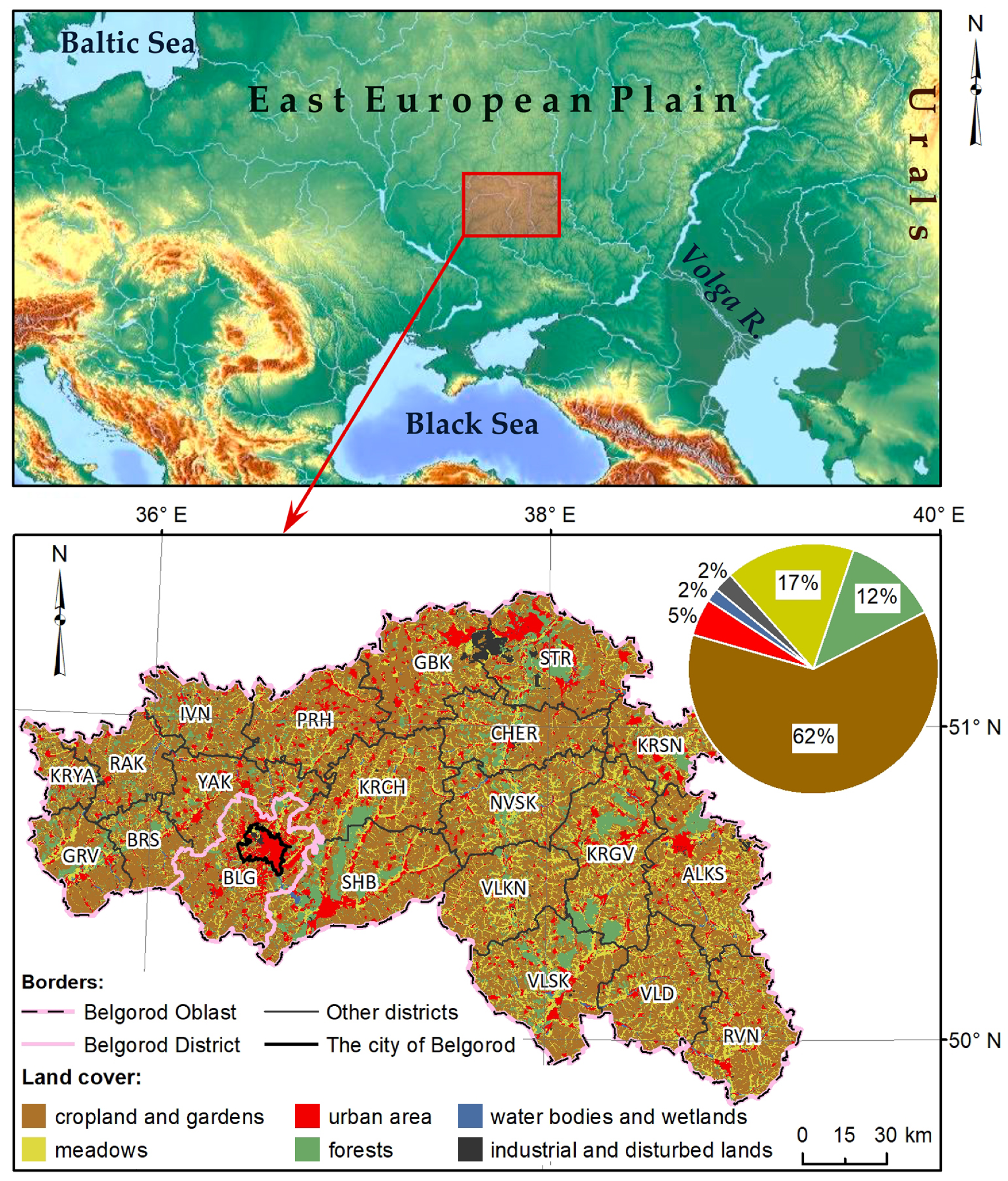

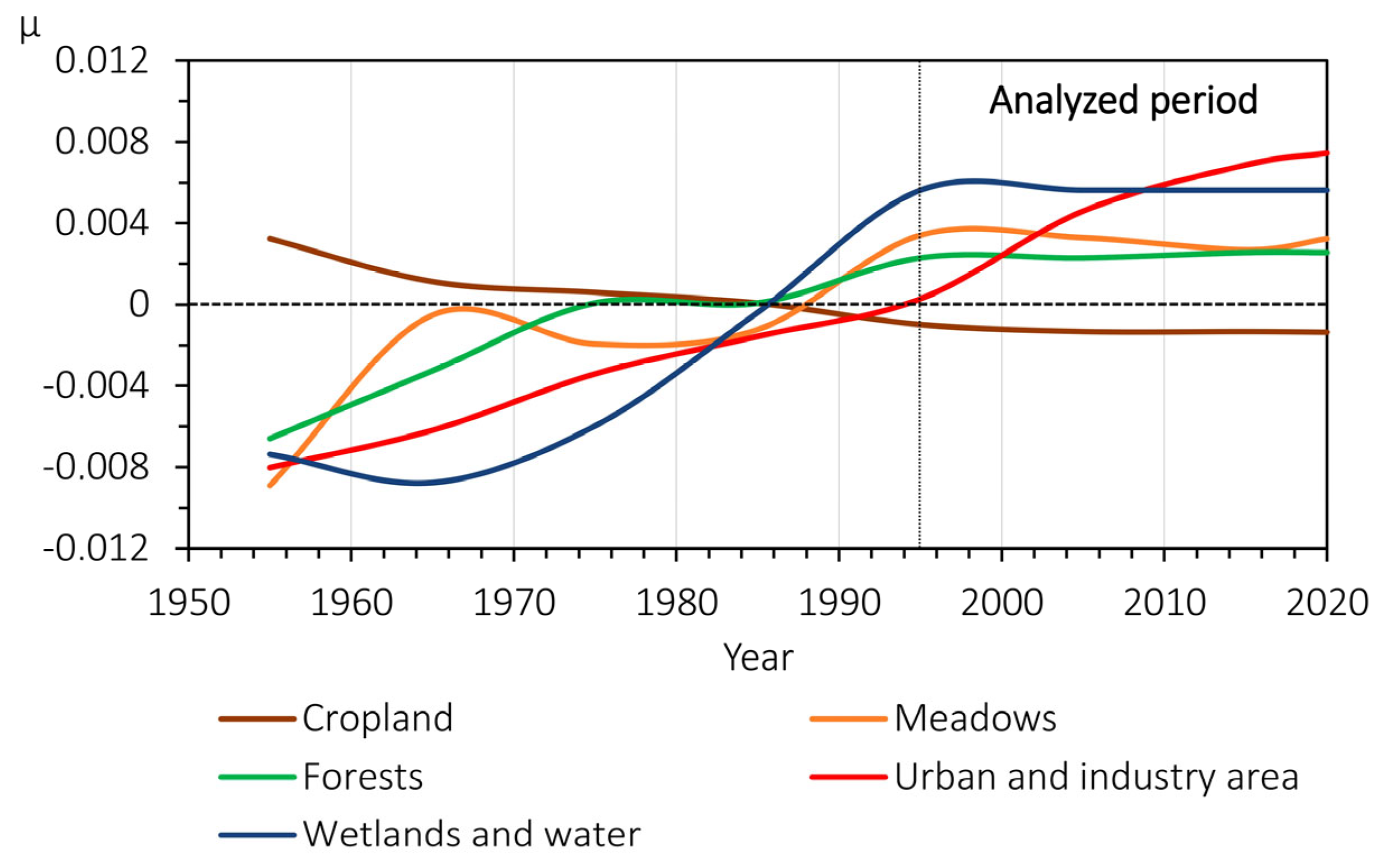
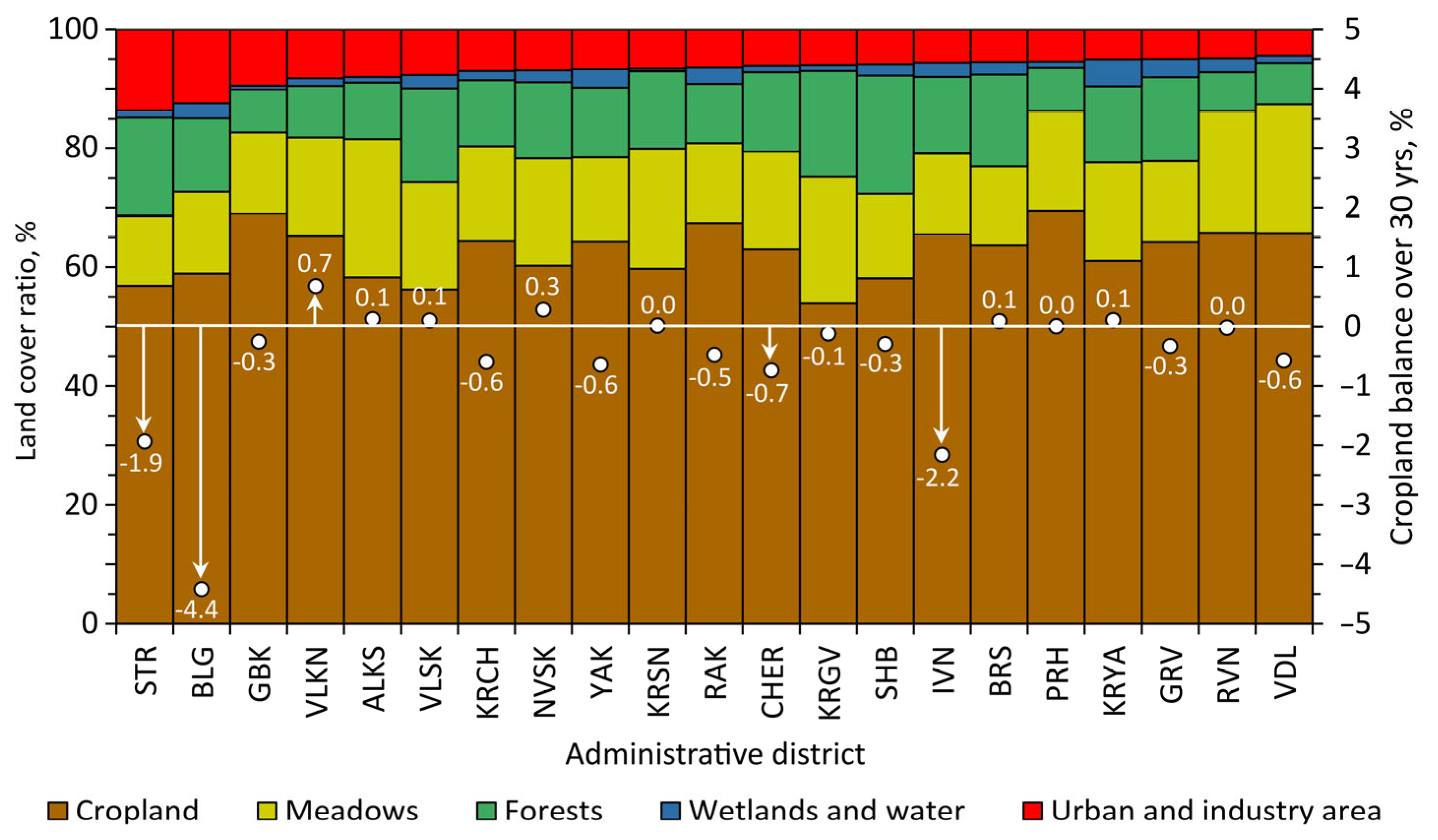
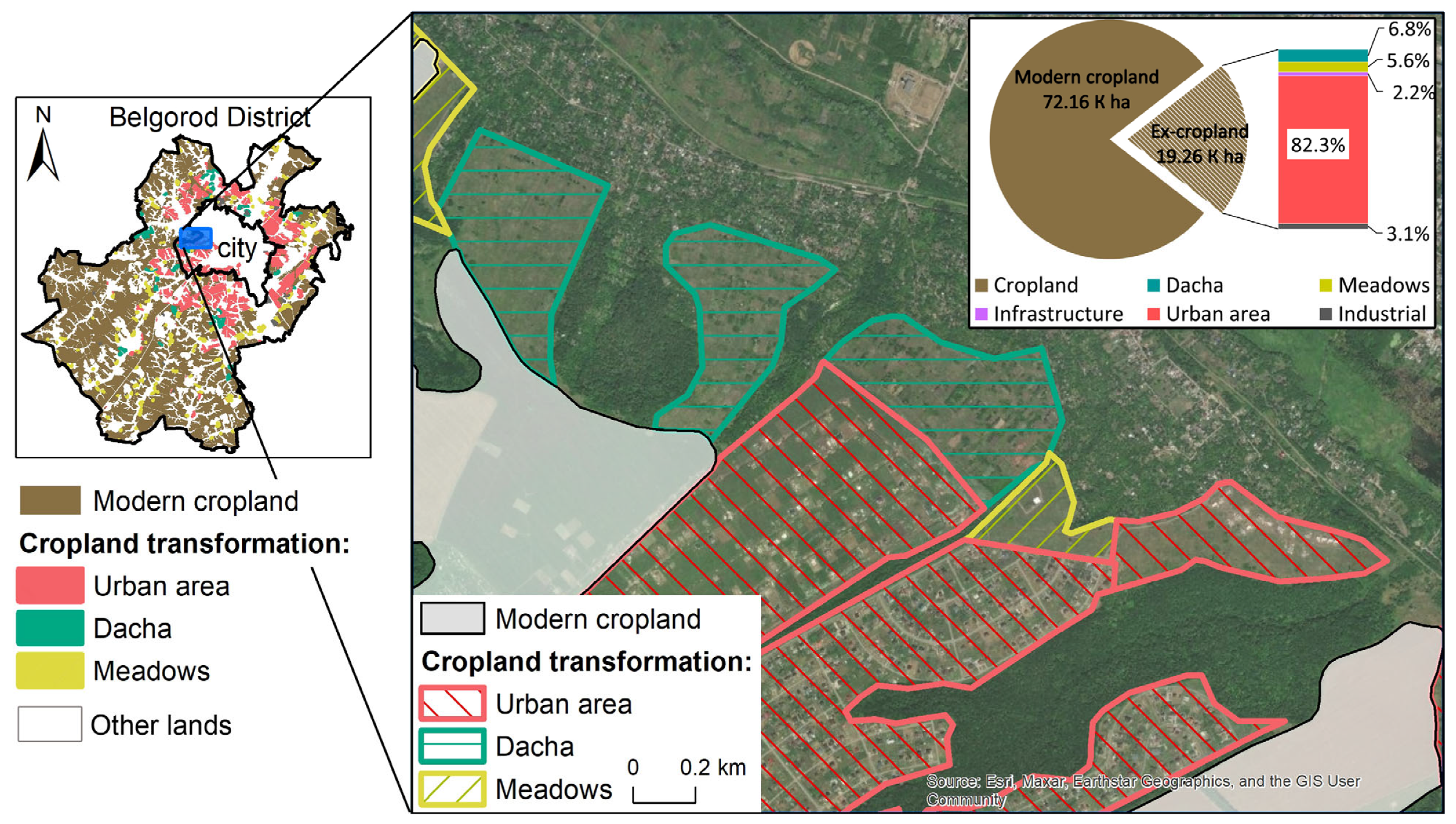
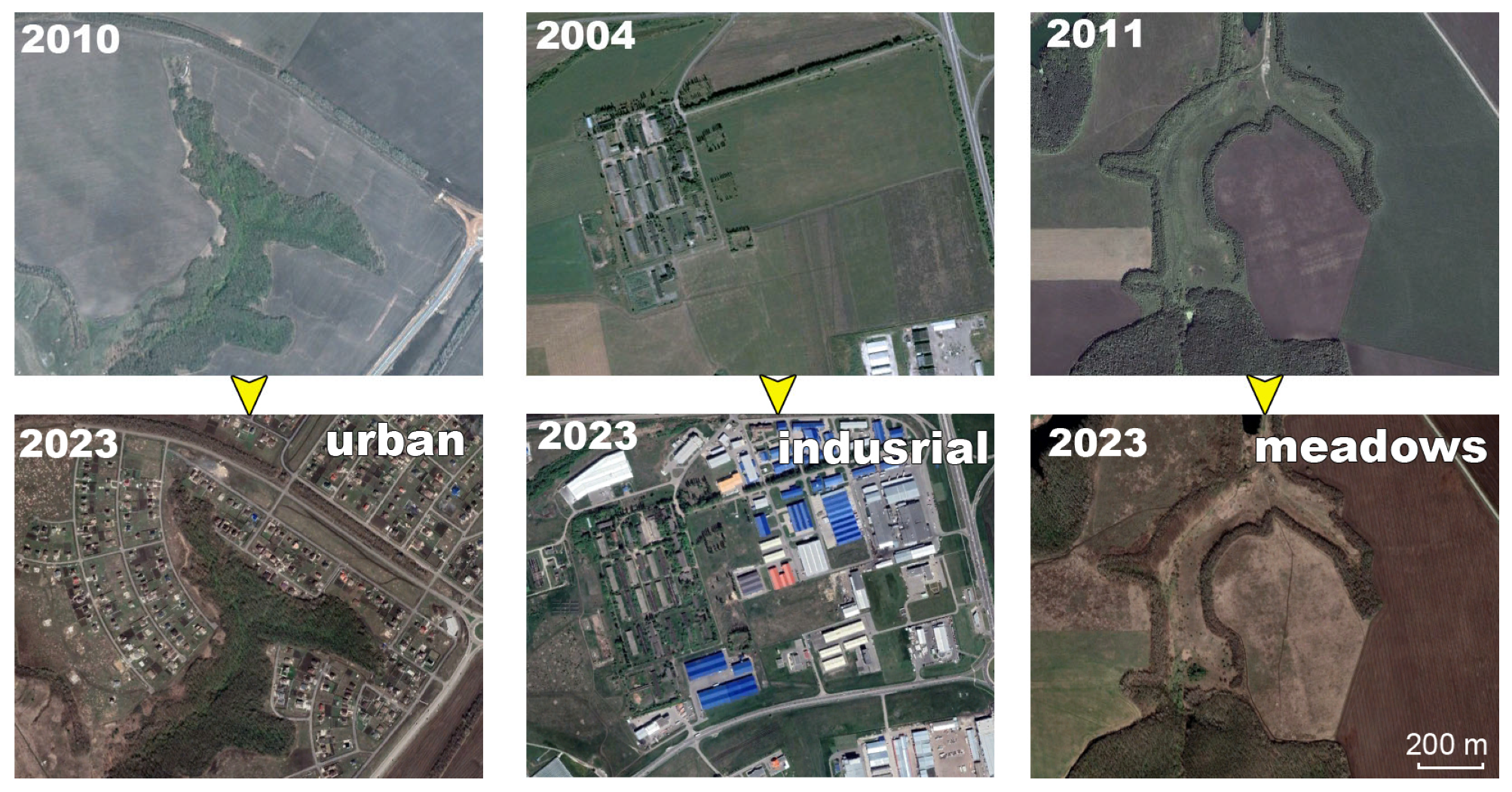
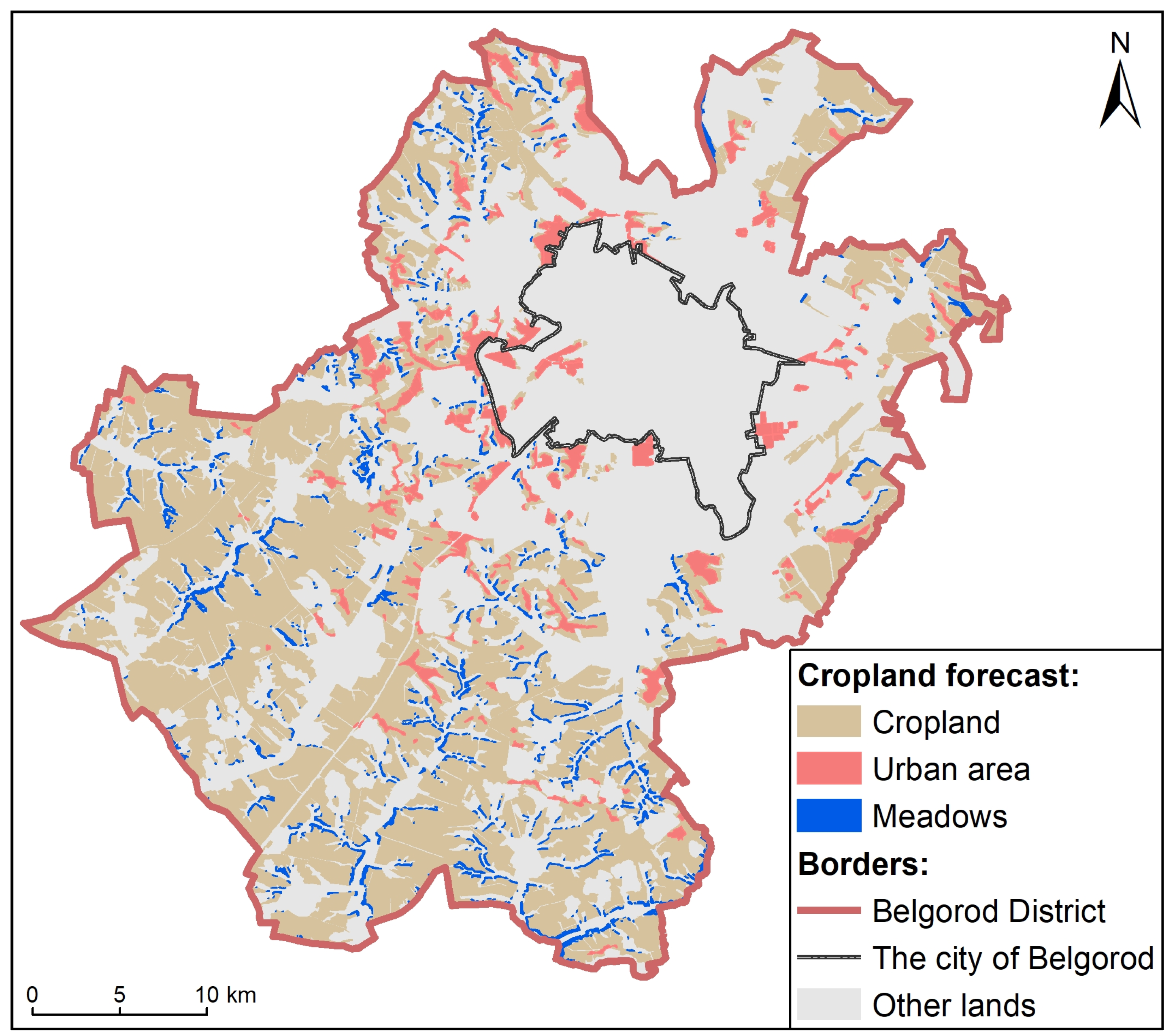
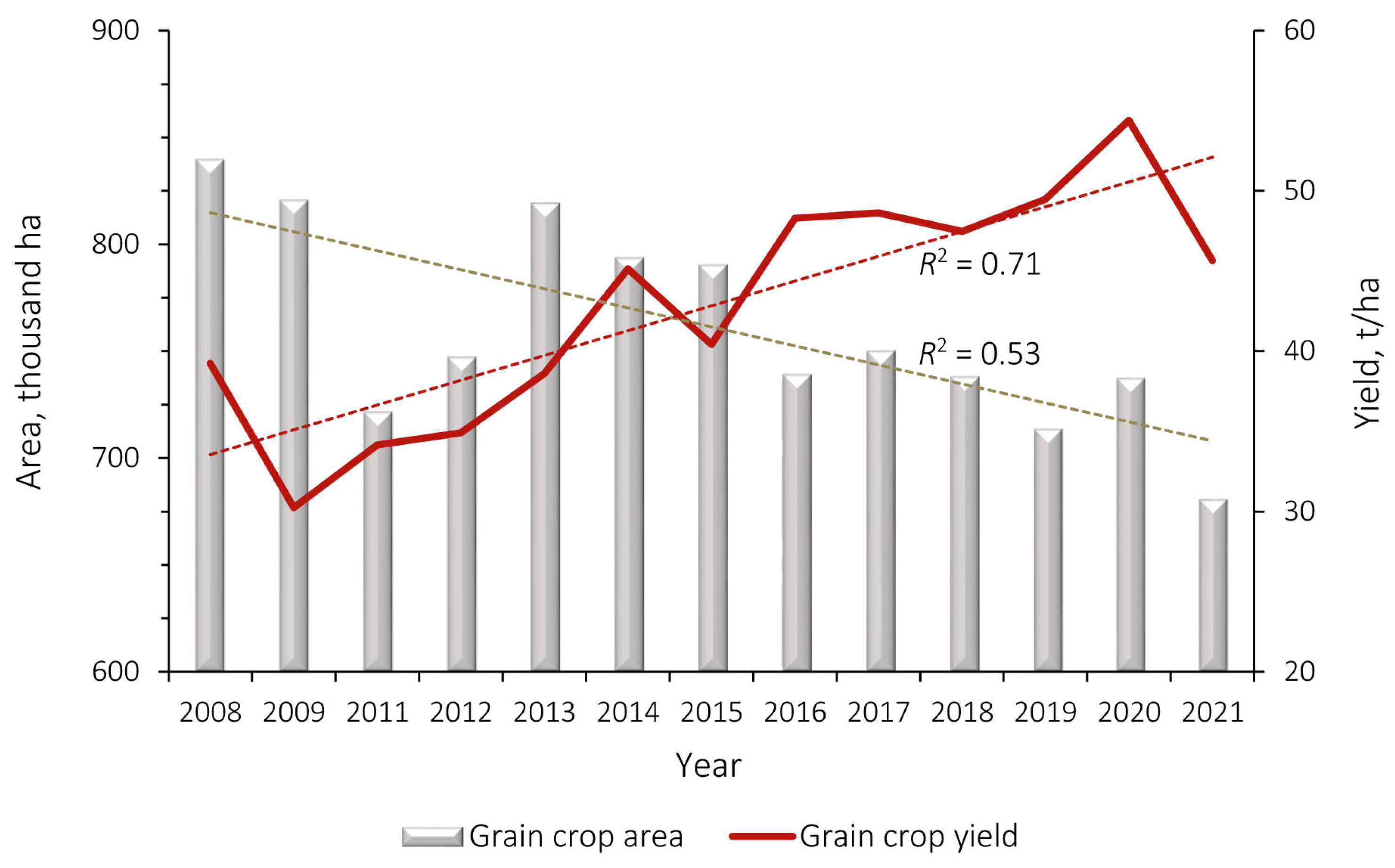
| Variable | Cropland | Meadows | Forests | Wetlands and Water | UIA | Other Lands |
|---|---|---|---|---|---|---|
| Cropland | — | –0.39 | –0.21 | –0.15 | –0.63 | –0.23 |
| Meadows | –0.39 | — | –0.13 | –0.03 | 0.22 | –0.43 |
| Forests | –0.21 | –0.13 | — | 0.31 | –0.04 | 0.11 |
| Wetlands and water | –0.15 | –0.03 | 0.31 | — | –0.07 | 0.42 |
| UIA | –0.63 | 0.22 | –0.04 | –0.07 | — | 0.22 |
| Other lands | –0.23 | –0.43 | 0.11 | 0.42 | 0.22 | — |
| Estimation of Correlation and Regression Equation as a Whole | ||||
|---|---|---|---|---|
| Multiple R | R2 | Fc (2;59) | p-Value | SE |
| 0.84 | 0.71 | 70.72 | <<0.05 | 0.22 |
| Estimating the parameters of the regression equation | ||||
| Variable | β0-k | tc (59) | p-value | SE |
| Free member β0 | –0.056 | |||
| Independent variable (X1-k): | ||||
| Meadows | –0.798 | –7.66 | <<0.05 | 0.10 |
| UIA | –0.954 | –8.59 | <<0.05 | 0.11 |
| Model | Predictors (p > 0.05) | Accuracy, % | χ2 | p-Value | AUC | Residue Distribution |
|---|---|---|---|---|---|---|
| UAI | L, D, S, TPI | 76.0 | 169.24 | <<0.0001 | 0.85 | Normal |
| Dachas | L, D, S | 0 | 29.1 | <<0.0001 | 0.74 | Abnormal |
| Meadows | I, S, TPI | 64.8 | 132.50 | <<0.0001 | 0.83 | Normal |
| Predictors | UIA | Meadows | ||||||
|---|---|---|---|---|---|---|---|---|
| Value | SE | χ2 | p-Value | Value | SE | χ2 | p-Value | |
| β0 | 2.78 | — | — | — | –0.44 | — | — | — |
| L | −0.08 | 0.02 | 20.73 | <0.0001 | Not included in the model Not included in the model | |||
| D | −0.72 | 0.15 | 23.28 | <0.0001 | ||||
| I | Not included in the model | −0.06 | 0.01 | 17.19 | <0.0001 | |||
| S | −0.45 | 0.08 | 31.86 | <<0.0001 | 0.17 | 0.06 | 6.65 | 0.01 |
| TPI | 0.04 | 0.01 | 16.76 | <0.0001 | −0.06 | 0.01 | 35.44 | <<0.0001 |
Disclaimer/Publisher’s Note: The statements, opinions and data contained in all publications are solely those of the individual author(s) and contributor(s) and not of MDPI and/or the editor(s). MDPI and/or the editor(s) disclaim responsibility for any injury to people or property resulting from any ideas, methods, instructions or products referred to in the content. |
© 2023 by the authors. Licensee MDPI, Basel, Switzerland. This article is an open access article distributed under the terms and conditions of the Creative Commons Attribution (CC BY) license (https://creativecommons.org/licenses/by/4.0/).
Share and Cite
Buryak, Z.A.; Grigoreva, O.I.; Gusarov, A.V. A Predictive Model for Cropland Transformation at the Regional Level: A Case Study of the Belgorod Oblast, European Russia. Resources 2023, 12, 127. https://doi.org/10.3390/resources12110127
Buryak ZA, Grigoreva OI, Gusarov AV. A Predictive Model for Cropland Transformation at the Regional Level: A Case Study of the Belgorod Oblast, European Russia. Resources. 2023; 12(11):127. https://doi.org/10.3390/resources12110127
Chicago/Turabian StyleBuryak, Zhanna A., Olesya I. Grigoreva, and Artyom V. Gusarov. 2023. "A Predictive Model for Cropland Transformation at the Regional Level: A Case Study of the Belgorod Oblast, European Russia" Resources 12, no. 11: 127. https://doi.org/10.3390/resources12110127
APA StyleBuryak, Z. A., Grigoreva, O. I., & Gusarov, A. V. (2023). A Predictive Model for Cropland Transformation at the Regional Level: A Case Study of the Belgorod Oblast, European Russia. Resources, 12(11), 127. https://doi.org/10.3390/resources12110127







